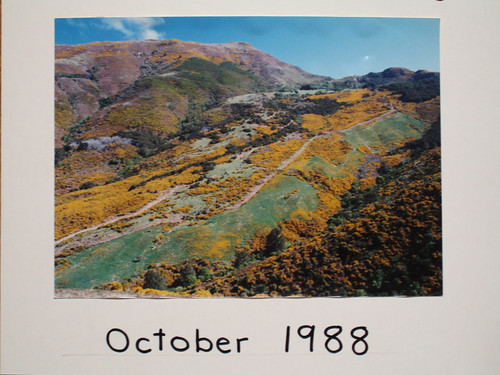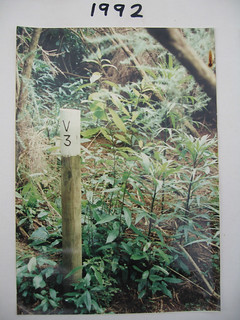RECENT ARTICLES
- CEBRA: An optimised and standardised sampling protocol for BioBlitz
- Stop it people, the plural of anecdote IS data!
- That's no pollinator, that's a flower visitor
- Add a scale to your macro photos
- What to photograph when counting the wild
- Imagine counting the wild on EVERY street in a city!
- My wild counting workflow
- A butterfly flew through
- Why iNaturalist observations without photos can be research grade
- Why you shouldn’t use a spreadsheet for data entry
- All articles ...
Wait, don't plant! Forest restoration ≠ gardening.
What’s the hurry? If restoration of nature is really our goal, why won’t we let it happen naturally?
written Jun 14, 2018 • by Jon Sullivan • Category: Wild Soapbox

When we do something, we want to see results quickly. It’s human nature. If we email someone, we want an instant reply. If we order something online, we want it delivered now.
This restless impatience of ours is only encouraged by our latest gadgets. There’s no time to pull a phone from your pocket; get messages on your wrist! Courier delivery too slow? Use drones! I see this same attitude in our hurry to fix the damage that we do to nature. Why wait decades for nature to make a wild forest when we can plant trees now?
In the places that we select for nature restoration, there is often a desire, even a perceived obligation, to make improvements quickly. Is an existing forest reserve too small? Let’s plant lots of trees around it. Are seedlings struggling to establish in grass? Spray herbicide, and spray it often. Are trees growing slowly? Irrigate, fertilise, plant nitrogen-fixing legumes. Is forest succession faster through woody weeds than natives? Great! Keep the weeds. Are some species missing from an area? Let’s plant them in today!
In this age of accelerating global warming, there’s also the pressing realisation that we need to suck as much carbon out of the air now as we can. That’s so we can gradually phase out driving our private fossil fuel cars over the next couple of decades. So, let’s plant trees wherever we can. Let’s include some native trees in the mix, but the faster growing the tree, the better.
This is all very hands-on, it gets results, and it’s satisfying to see forest return because of our hard work. It feels good.
It’s also, for the most part, both unnecessary and unnatural. Our impatience is creating ecological communities that will retain the imprint of our efforts for centuries ahead. It also feeds our perception that nature is a delicate, vulnerable thing that needs our care to thrive. It’s not.
Instead, good things take time. If given the time and space, nature will largely return on its own. It will look untidy, especially initially, and will not look like a tidy, planted arboretum. It will be wild! For sites that are primarily for nature, that should be what we want.
The Hinewai Experiment
Banks Peninsula’s Hinewai Reserve in New Zealand is a shining example that native forest can replant itself, if given time. Banks Peninsula is a long extinct group of volcanos next to what is now Christchurch city. At the time of human settlement it was all forested, with few exceptions like rocky outcrops and wetlands. European settlers, especially, were responsible for clearing almost all of this forest, and converting it to farms and towns. Less than 1% of the original forest remains. Hinewai Reserve was established to fulfill a dream to return marginal farmland to forest in one Banks Peninsula catchment.
Before Hinewai began, botanist Hugh Wilson had been tasked with doing an extensive botanical survey of Banks Peninsula. The results of Hugh’s detailed survey are still widely used today, over 30 years later, for conservation planning and research. Hugh’s exploration of the Peninsula’s plant life opened his eyes to how resilient nature had been, despite the past century and a half of forest clearance. In Hugh’s words, “it dawned on me that native plants and animals were proving far more resilient and resourceful than people gave them credit for.” (That quotation is from Hugh’s 2002 book, “Hinewai: The Journal of a New Zealand Naturalist”.)
Hinewai Reserve started in 1987 with the purchase of Tom and Eli Bates’ 109 hectare farm in Otanerito Valley by the Maurice White Trust. Maurice was a Christchurch-based businessman with a love of nature, and asked Hugh to keep an eye out for a site that could be suitable for a forest sanctuary. The Bates’ farm was ideal, as it had one of the very few remnants of old growth beech forest, a few tall remnant pododcarp trees, and young woody patches in its gullies of kanaka (an early succession native tree) and gorse (a woody weed from Europe). Maurice’s Trust employed Hugh to be the manager of the Hinewai project. Subsequent purchases of adjacent properties have now expanded Hinewai to 1,230 hectares.
In most such projects in New Zealand, the land purchase would have been followed by a flurry of enthusiastic tree planting by community volunteers. Not Hinewai. Hugh had already been convinced that nature can take care of itself, if given the chance. The Hinewai management philosophy was, and remains, one of minimal interference: only the worst weeds and mammalian pests are controlled and nature does all the planting.


The results speak for themselves. Hinewai is now filled with lush young native forest and an abundance of native birds. Areas that were gorse in 1987 are now a mixed native forest with hardly a spindly old gorse to be found. Areas that were pasture are now gorse and kanuka in early stages of forest succession. Even a large fire in 2011 was followed by a roar of native regeneration, more vigorous and diverse now than what the reserve was capable of in 1987.
Another usual practice in forest restoration projects in New Zealand is community operated trap lines, to kill invasive mammalian predators like stoats, feral cats, and rats. This is done to bring back the birds. Again, Hinewai has biked down the road less travelled. It only consistently controlled the goats, deer, and brush-tailed possums, which inhibit forest regeneration. Despite this, Hinewai’s bird life became rich and abundant, containing thriving populations of all the forest bird species still present on Banks Peninsula. Hinewai makes clear that the main reason why these birds are no longer everywhere all over Banks Peninsula is not the mammalian predators. It’s the lack of large areas of healthy forest. (Sadly, the bird species most sensitive to mammal predation are all already gone from Banks Peninsula. Those definitely need mammalian predator control if they are to return.)
The Hinewai experiment teaches us two important lessons. The big lesson is that making forest habitat in places like Hinewai does not require planting. Just apply a little weed and pest control and wait. The second is that, for the remaining Banks Peninsula forest bird species, while mammalian predators are a big problem, the biggest problem is not enough suitable forest habitat.



When and how to intervene
Of course sometimes we should intervene. Minimal interference is very different from no interference. The worst pests and weeds most definitely need controlling.
In landscapes completely stripped of native vegetation, like New Zealand’s agricultural Canterbury Plains, planting is completely necessary, to kick-start native dominated vegetation. Many native plant species would take many decades, probably centuries, to find these patches, and before then local weeds would have completely reshaped those forest communities. Translocations of lost species is needed.
Mammalian predators removed many bird species from Banks Peninsula. Those birds that aren’t extinct throughout New Zealand will need predator control on Banks Peninsula if they are to return (once enough old forest has regrown). In other parts of New Zealand, where such birds are still present but dwindling, they most definitely need mammalian predator control to survive and expand.
Global warming also complicates things. Warming the planet faster than has likely ever happened before is shifting habitat conditions across landscapes faster than many species can disperse. Many species, indeed whole ecosystems, may need help moving beyond their current natural distributions in a world of rampant global warming. By far the best solution here is to reverse the dangerously rapid build up of carbon dioxide and methane in the atmosphere. Otherwise, human-assisted long-distance dispersal of species will be needed for many places and species.
Tree planting is often seen as part of the solution to global warming. Trees do remove carbon from the air as they grow (they’re built of the stuff) but tree planting won’t save us from fossil fuel burning. Personally, I’d rather ride a bike and wait a couple of decades for forest to regenerate naturally, rather than drive a car and plant trees. Widespread planting of common trees is also quite different from targeted range expansion of those rarer species at risk of being overtaken by rapid climate change.
Think twice before planting
The Hinewai experiment in minimal interference shows that a lot of nature can take care of itself if given the chance, and time. Even with no predatory mammal pest control, Hinewai has become a valley filled with native birds.
As an ecologist, I want to see all of Banks Peninsula become a vibrant, wild, native-dominated mix of wildlands, farms, and towns, like the Banks Peninsula’s “Wildside” area around Hinewai is becoming. I don’t want it becoming a big planted arboretum and zoo for native species. I’m as keen as everyone else to eventually see lost birds return to the Peninsula from far away. However, that will best be done when Banks Peninsula’s landscape has been transformed into something that can sustain these populations long-term without needing intensive ongoing management. That will be when the early successional scrub and forest has matured to tall forest, and technologies for eradicating mammalian predators at a landscape scale have matured. I see no reason for the rush to do this.
I’m not convinced that restoration planting is needed on most of Banks Peninsula. It is necessary on the completely deforested Canterbury Plains, where all local forest seed sources are long gone, but it doesn’t make sense on most of the Banks Peninsula. Fencing off areas from the surrounding farms’ sheep and cattle,controlling browsing mammalian pests, and suprressing the worst weeds, will then let nature do all the planting. By planting, we take away the wilderness from those forests. It will inevitably do all sorts of weird things to vegetation succession and population genetics and leave a long-term imprint on the forest.
A lot of the phenomenal community effort being put into planting around New Zealand, and other parts of the world, could, I expect, be as well spent weeding and monitoring and understanding nature. Planting in many places is unnecessary. It erases the potential for those places to be truly wild, in our life times or the life times of our children or grandchildren. We need to be more patient. In Hugh Wilson’s words, all we need to do to bring back wild forest is “remove the worst impediments to natural regeneration, and let Nature have full reign to gallop ahead.”
[Coming up next: we dive deeper into how to decide where and when tree planting is really necessary.]
